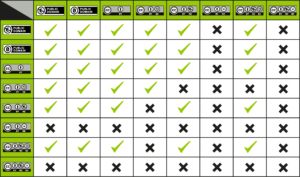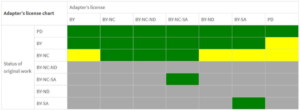7 Copyright and OER
Copyright Considerations when Adopting OER
Adopting OER materials in a course–e.g. switching out a traditional textbook for an OER textbook–is the simplest use case in terms of copyright. In this instance, your responsibility is to ensure that you fully understand the licenses of the works you are considering and determining if the allowed uses are consistent with how you intend to use the work. Our chapter on Creative Commons Copyright Tools can help you understand the different licenses that you will come across when evaluating OER. Whichever text you choose, we advise that you carefully read the associated license as it is your responsibility to ensure that your usage of the work complies with the license.
Copyright Considerations when Adapting and Remixing or Making Collections
There are two main ways that you can adapt OER by combining two or more works.
Adaptation or Remix. A remix or adaptation is when you build on an existing work to create a new work. In a simple adaptation you would add your own content–e.g. examples, explanations, course specific information–to an existing work. When remixing, you combine elements from two or more OERs with your own content to create a completely new work. In this instance, it is difficult, if not impossible, to determine where one work ends and anther begins. You can think of this type of use as a smoothie, where the different OER are the fruit and vegetables that you add to the smoothie. Once blended together, the resulting drink is a completely new creation (see image below left: CC Smoothie). The addition of new creativity is an essential part of determining if something rises to the level of an adaptation.
Collection. A collection is when you select a group of works, unchanged from the original, and organize them as distinct elements within a larger whole. You can think of a collection as a TV dinner, the different elements are complementary, and they are kept separate from each other (see image below right: “CC TV Dinner”).

Adapting and Remixing OER
Some general rules to keep in mind when remixing OER are:
- Always make sure that you have properly attributed all of the works you have used.
- You cannot distribute adaptations that you made from works licensed with non-derivative licenses.
- If you adapt or remix a work with an SA license, then you much license your work with the same license or a compatible one.
- When remixing several works, you should always pay attention to license compatibility. This concerns determining which OERs have compatible licenses and can be combined.
- When choosing a license to put on a derivative that you have created (aka the Adapter’s License) you much take into consideration which type of license is compatible with the underlying license(s).
License Compatibility for Remixing Works
When remixing two or more works, you need to make sure that the works you will be using have compatible licenses. This chart can help you determine which licenses are compatible. Find the license of one work in the left-hand column, and the licenses of the other work in the top row. A ✓ in the box where they meet means that the licenses are compatible. An X means that they are not compatible unless a copyright exception or limitation, like Fair Use, applies. Remember, a CC license cannot disallow uses granted under copyright.

Choosing an Adapter’s License
When deciding on an Adapter’s License, remember that it only pertains to your content. The original works will still be licensed under their original licenses. The below chart can help you decide which license to apply to your derivative. Find the license of the original work in the left-hand column, then read across the row to see which licenses you can use. Licenses with a green box are recommended by the Creative Commons. Those marked yellow are not technically incompatible, but the Creative Commons recommends against them. If you do decide to use one of these, you should make it clear that your work is made up of works under different licenses so that downstream users are aware of their obligations. Licenses that are grey are incompatible.
-
- If an underlying work is licensed with an SA license, they you must license your work with the same or a compatible license.
- If an underlying work is licensed with an ND license, then you cannot distribute your work.
- If a work has been licensed with a BY or BY-NC, then it’s recommended that the Adapter’s License have the same elements. If you adapt a work with a BY license, then you should apply a BY or BY-NC license. If you adapt a work with a BY-NC license, you should apply a BY-NC license.
- If remixed two or more works, then you should use the most restrictive of the original licenses to determine your Adapter’s License.

Creating Collections from OER
If you create a collection using parts of CC licensed works–for example creating a textbook using chapters from five different OER textbooks–then the elements in the collection retain their original license as long as each chapter is unchanged from the original. If you add elements, like an introduction or separate chapters of your own, then they would be separate copyrights that you can license. You can also license the selection and arrangements of the elements in the your work. You need to clearly attribute each different elements so that downstream users know what their obligations are if they choose to reuse or remix elements of your collection.
As the elements in the collection are unchanged from the originals, a collection does not qualify as an adaptation, so you don’t have to apply a ShareAlike-license to your collection even if one or more of the underlying works has such a license. Additionally, you can include elements from ND licensed works. You just have to make sure that you comply with the NC license terms if any underlying work is so licensed.
Copyright Considerations when Authoring OER
When authoring OER, it is our choice how to license the work. Some things to keep in mind:
- In general, works that are licensed with a NoDerivatives license are not considered OER as this restriction prevents faculty from remixing your work, one of the essential Rs of Openness.
- Dedicating your work to the Public Domain gives others the most freedom to build on your work. Keep in kind, however, that this means they can do anything with your work, including selling it as is and otherwise making money from it.
- NonCommercial and ShareAlike licenses are popular choices for OER authors, just keep in mind that these licenses may prevent some uses of your work–primarily when remixing with other works under incompatible licenses (see CC License Compatibility Chart above).
The Creative Commons’ License Chooser tool can help you figure out which license is right for your work.
Media Attributions
- CC Remix Or Collection © Nate Angell is licensed under a CC BY (Attribution) license
- CC License Compatibility Chart © Kennisland is licensed under a CC0 (Creative Commons Zero) license
- CC Adapter’s License Chart © Creative Commons is licensed under a CC BY (Attribution) license

